Robotic Rice Cookers
Future
|
Automated Appliances:
Robotic Rice Cookers Future Wahiawa Middle School -
Team
#05-0099
|
<Introduction>
<History> <Current> <Future> <Bibliography> <About
Us>
Technology
today is constantly being
upgraded to make our lives easier. An
example of this is the cell phone which no longer is used just for
calling but
can also be a walkie talkie, a camera, a video camera, a text
messenger, and a
web browser[11]. In
the future, cell phones
could be used as remote controls for many household appliances.
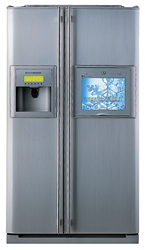 LG
Electronics, a Seoul-based company which is a leading vendor of digital
appliances has come up with an idea for an entire network of home
appliances
accessible over the Internet and capable of talking to each other when
people are
not at home. Their system called HomNet
incorporates a new protocol called LnCP, which allows the use of
existing
electrical wires in the home to make appliances talk to each other. It would consist of a refrigerator, a washing
machine, a microwave oven, an air conditioner, and a digital projection
television, with the refrigerator acting as the server since it is
always on. All the other appliances would
be monitored from
the refrigerator[5]. It is only a
matter of time before a rice cooker will be part of this network.
LG
Electronics, a Seoul-based company which is a leading vendor of digital
appliances has come up with an idea for an entire network of home
appliances
accessible over the Internet and capable of talking to each other when
people are
not at home. Their system called HomNet
incorporates a new protocol called LnCP, which allows the use of
existing
electrical wires in the home to make appliances talk to each other. It would consist of a refrigerator, a washing
machine, a microwave oven, an air conditioner, and a digital projection
television, with the refrigerator acting as the server since it is
always on. All the other appliances would
be monitored from
the refrigerator[5]. It is only a
matter of time before a rice cooker will be part of this network.
http://www.popularmechanics.com/technology/telecom/1279916.html
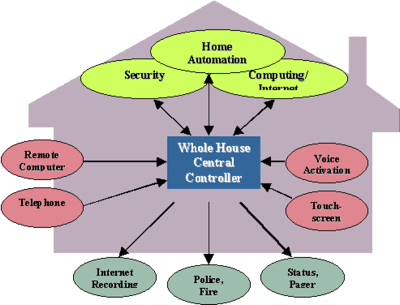
http://hometoys.com/htinews/aug99/articles/homs/jones.htm
Our Solutions
Imagine
a rice cooker that is totally
autonomous that has automatic measuring and self washing functions. It would have a built-in intelligence system
that is part of a home network that can be controlled by text
messaging, voice
activation, or a phone call from a cell phone.
It will be able to dispense the rice, wash it, and then cook it
at a
predetermined time. Kitchens might even
be designed to accommodate the rice cooker much like they are for the
range and
dishwasher.
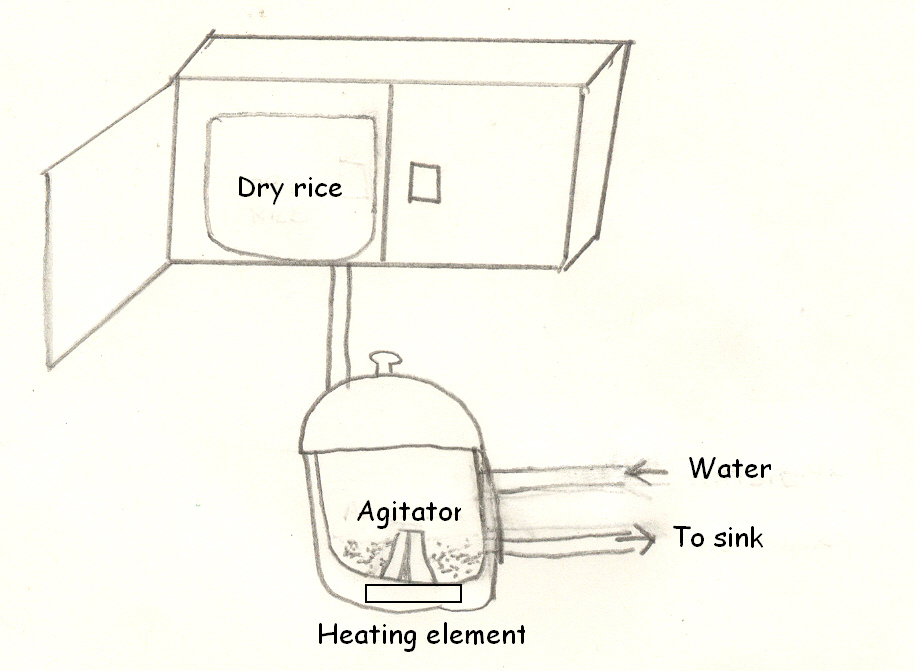 Our
first solution has a pot that
looks like the inside of a washing machine and is able to store and
dispense
the rice from a cabinet above. There is
a hose connected to the faucet for water to enter and another for the
water to
drain to the drain pipe. It will have a
built-in intelligence system that can be controlled through a cell
phone. A timer can be activated that can
set the
amount of rice to dispense from the storage bin, the time to wash it,
and the
time to cook it. The problem with this
model is that the agitator is part of the pot, so when the rice is
being
scooped out, the agitator could be damaged.
Also, the storage system for the dry rice would take up a lot of
space
especially since people in
Our
first solution has a pot that
looks like the inside of a washing machine and is able to store and
dispense
the rice from a cabinet above. There is
a hose connected to the faucet for water to enter and another for the
water to
drain to the drain pipe. It will have a
built-in intelligence system that can be controlled through a cell
phone. A timer can be activated that can
set the
amount of rice to dispense from the storage bin, the time to wash it,
and the
time to cook it. The problem with this
model is that the agitator is part of the pot, so when the rice is
being
scooped out, the agitator could be damaged.
Also, the storage system for the dry rice would take up a lot of
space
especially since people in
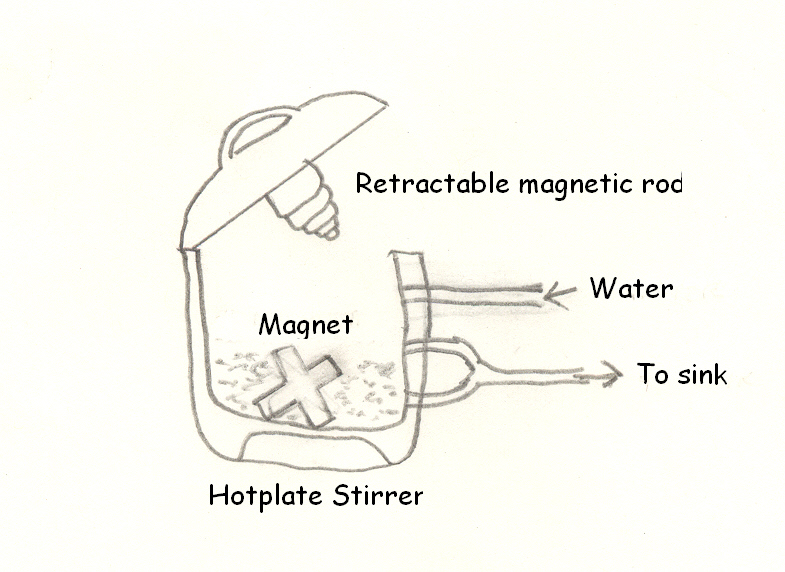 Our
next model has the same
autonomous features but is like a hotplate stirrer.
The hotplate stirrer would have a heating pad with a magnet
inside. The hotplate
magnet can spin, so if we added a cross shaped magnet inside the rice
pot, it
would get spun by the other magnet and wash all the talc preservative
out. It would have a retractable magnetic
rod in
the cover to pick the cross shaped magnet out of the rice when rinsing
was
completed. The rice cooker would have a
hose connected to the faucet (like a washing machine) and 2 hoses for
the dirty
water to drain. The cost would be roughly
$330 since a hotplate stirrer costs about $215[15] and a rice cooker
with a
timer about $115[14] (half the price
because the heating cost is covered by
the
hotplate stirrer), plus the plumber's and carpenter's fee for
installation, and the cost for a cell phone with Internet access.
When we thought further,
it occurred to us that it would be simpler to not have a magnet to pick
up out
of the rice. This led to our next idea.
Our
next model has the same
autonomous features but is like a hotplate stirrer.
The hotplate stirrer would have a heating pad with a magnet
inside. The hotplate
magnet can spin, so if we added a cross shaped magnet inside the rice
pot, it
would get spun by the other magnet and wash all the talc preservative
out. It would have a retractable magnetic
rod in
the cover to pick the cross shaped magnet out of the rice when rinsing
was
completed. The rice cooker would have a
hose connected to the faucet (like a washing machine) and 2 hoses for
the dirty
water to drain. The cost would be roughly
$330 since a hotplate stirrer costs about $215[15] and a rice cooker
with a
timer about $115[14] (half the price
because the heating cost is covered by
the
hotplate stirrer), plus the plumber's and carpenter's fee for
installation, and the cost for a cell phone with Internet access.
When we thought further,
it occurred to us that it would be simpler to not have a magnet to pick
up out
of the rice. This led to our next idea.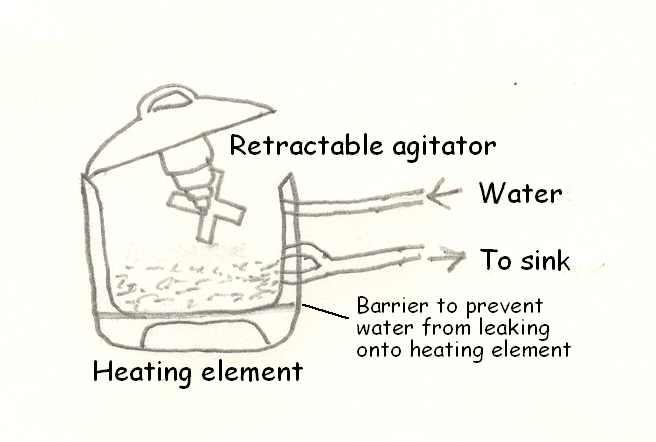
Our
final idea has all the autonomous
features but is a combination of our first two ideas.
It would have a retractable rod on the lid
with a cross shaped metal end. The metal
end would rotate left and right just like a washing machine. It will have two hoses with strainers
connected
to the sides. One will be in the middle
of the cooker just above the maximum height of the dry rice and the
other will
be close to the bottom. The reason for
this is because the talc preservative is mainly floating on the top so
the
top hose
will drain most of it and the bottom hose will drain the
rest of
the water. Lastly, the hoses would have
a sliding door for closing them off while the rice is being mixed or
cooked. The cost would be roughly $238 because a
small mixer costs about $8[16], and a
rice cooker about $230[14], plus the
plumber's and carpenter's fee for installation, and the costs for a
cell
phone with Internet access.
What's
Holding This Back....
The cost of the
cell phone, rice cooker, and the automation technology are holding back
development of such a rice cooker. The cost of our rice
cooker, being over $200 is about 4 times that of a standard rice
cooker. A home automation controller could cost almost $1000[12]. Everyone would have to be
using cell phones that have Internet access.
Technologically challenged people would
also have a difficult time or might not be receptive to this advanced
level of technology. It wouldn't look so nice in your kitchen
unless your kitchen was renovated to hide the hoses.
We don't think the world is
ready to spend that much on rice since it is not a staple on the
continental U.S.A. However, as home automation systems
become
common or are built into new houses, it is only a matter of time before
price come down and appliances like our rice cooker will become part of
the home
network.